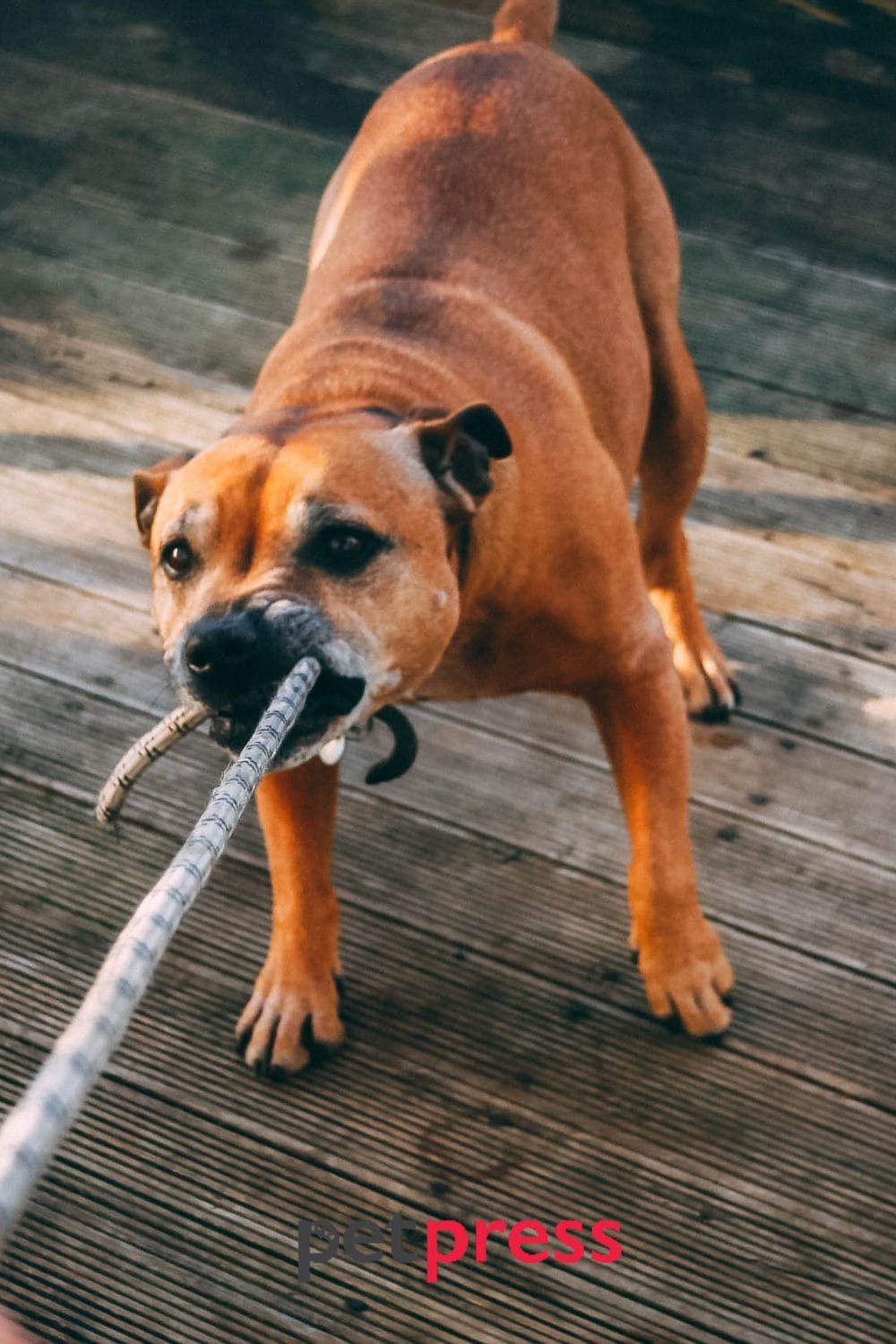
If you’re a proud owner of a boxer dog, you know these affable canines are packed full of vibrancy and vigor. Their boundless energy will surely keep you on your toes. A crucial part of maintaining their vitality and well-being? Regular Boxer dog exercise!
In this comprehensive guide to boxer dog exercise, we delve into the importance of keeping your furry friend active, the best routine exercise for them, and how to ensure they get enough, but not too much, physical activity.
Fascinating Facts About Boxer Dogs
Boxer dogs are more than just adorable pets; they’re intriguing canines boasting a rich history and exhibiting unique traits. If you’re a boxer dog enthusiast or you’re considering adopting one, here are some interesting facts about this beloved breed.
- They Have a Storied History. Boxers can trace their roots back to Germany in the late 1800s. They were bred from the now-extinct Bullenbeisser, a breed for hunting large game, and the English Bulldog.
- They Got Their Name in a Unique Way. Some believe it’s because this breed tends to stand on its hind legs and “box” with its front paws during play.
- They Were Among the First Police Dogs. Boxers have served in various roles throughout history, including as some of the first police and military dogs. Their intelligence, strength, and courage make them excellent working dogs.
- They’re Great with Kids. Boxers are known for their high energy levels and playful nature, making them great companions for children. They’re protective and patient, qualities that make them wonderful family pets.
- They’re Quite Vocal. Boxers make unique sounds, such as “woo-wooing,” grunting, and even some “talking” noise. However, they’re generally not excessive barkers.
- They Tend to Stay Puppies at Heart. Boxers are known as the “Peter Pan” of dogs, as they maintain their puppy-like nature for most of their lives. Their high energy levels and playful demeanor make them fun-loving pets throughout their lifespan.
Whether they’re making us laugh with their playful antics or impressing us with their intelligence and bravery, boxers are undoubtedly a special breed of dog that continues to win hearts worldwide.

Why is regular boxer dog exercise essential?
Boxers are high-energy dogs that need plenty of exercise to keep them healthy, both physically and mentally. It burns off excess energy, maintains a healthy weight, and stays mentally stimulated.
Physical Health
Without adequate exercise, a boxer could become overweight, which leads to a myriad of health problems such as heart disease, diabetes, and cancer. Regular exercise helps keep their weight in check and their body functioning at its peak.
Mental Well-being
Boxers are an intelligent dog breed, and they can easily become bored and resort to destructive behaviors. Exercise promotes mental stimulation, ensuring your boxer is content, satisfied, and well-behaved.

The Perfect Workout Trio for Boxer: Walking, Fetch, and Agility Training
Keeping a boxer dog active isn’t merely about scheduling an exercise routine. It’s about understanding the best forms of physical activity that cater to their innate strengths, abilities, and genetic makeup.
So, let’s dive deeper into three of the most effective exercises for your muscular and agile friend: walking or jogging, playing fetch, and agility training.
Walking or Jogging: A Daily Dosage of Fresh Air and Exploration
Boxers possess an inherent high energy level, making brisk walking or moderate jogging an ideal form of exercise.
These activities, while physically demanding, also provide excellent mental stimulation as they allow your furry friend to explore their surroundings. New scents, sights, and sounds can keep your boxer excited and eager for their daily walk.
Strive for a daily goal of 30 minutes to an hour of walking or jogging. Divide this into two parts: a morning session to jumpstart their day, and an afternoon or evening session to exhaust any leftover energy.
Remember, consistency matters. Try to stick to a daily schedule, as dogs thrive on routine.
Playing Fetch: A Fun Game With Health Benefits
Aside from being a fun game, fetch is also an effective exercise for boxers. This high-energy breed loves to sprint and jump, which fetch offers plenty of opportunities for.
Furthermore, if you toss the fetch toy in a way that is hidden or hard to reach, it introduces an element of problem-solving, providing mental stimulation.
Ensure the area is safe for your boxer to run around freely and avoid potential hazards. And remember, variety is the spice of life—rotate between tennis balls, frisbees, and other safe fetch toys to keep your boxer intrigued.

Agility Training: A Comprehensive Workout for Body and Mind
Combining physical exercise with mental stimulation, agility training can be an amazing form of exercise for boxers. It involves guiding your dog through an obstacle course where they must jump over hurdles, navigate tunnels, weave through poles, and more, all while following your commands.
Not only does agility training provide exhaustive physical workouts, but it also reinforces obedience skills and strengthens the bond between you and your pet. It requires your boxer to focus and follow instructions closely, promoting mental sharpness and better communication skills.
Starting agility training can be as simple as setting up homemade obstacles in your backyard. As your boxer progresses, you might consider joining a local club or group for a more structured and challenging course.
Agility training can be an excellent form of exercise for boxers. It offers physical exertion and mental stimulation and reinforces obedience skills.

Ensuring Adequate Exercise for Your Boxer: Puppies, Adults, and Seniors
Meeting the exercise needs of your boxer dog at different life stages can be a bit challenging. Exercise requirements vary depending on their age, health, and individual disposition. It’s crucial to tailor your pet’s exercise routine to align with these factors.
Here’s a detailed guideline on how to ensure your boxer gets adequate exercise throughout their life:
Exercise for Boxer Puppies: Balancing Energy and Rest
Boxer puppies are bundles of energy. They love to explore, play, and exert their newfound strength. However, they also need plenty of sleep to support their rapid growth and development. It’s advisable to have short, frequent play sessions throughout the day rather than long periods of intensive exercise.
Try introducing a variety of games, toys, and activities to keep these sessions fun and engaging. Remember to keep things light; high-impact exercises can be hard on a puppy’s developing joints.
The focus at this stage should be on exposure to different environments and socialization, along with gentle physical activities.
Exercise for Adult Boxers: Keeping Up With Their Energy
As your Boxer grows into an adult, their energy levels will remain high, requiring more substantial physical activity.
An adult boxer generally requires a minimum of one to two hours of physical activity daily. However, this doesn’t imply continuous, intense exertion for two hours. The exercise regimen can be disbursed over the day and comprise various activities such as walking, playtime, training, or engaging in dog sports.
Vary the types of exercises and mix both physical activities and mental stimulation to keep your boxer engaged and fulfilled. Monitor their response to the exercise levels. If they’re restless and destructive, they may need more physical activity. If they seem overtired or reluctant to exercise, it may be too much.
Exercise for Senior Boxers: Slowing Down but Staying Active
As your Boxer ages, their energy levels will gradually decrease. That doesn’t mean they no longer need exercise. Senior boxers still benefit greatly from regular, lighter exercise. It keeps them healthy, prevents weight gain, and can even help manage or slow the progression of certain age-related conditions.
Modify the exercise routine to accommodate your senior Boxer’s slower pace and any health issues they might be experiencing. It might mean shorter, more frequent walks, gentle play sessions, or light obedience work.
The main goal at this stage is to keep your Boxer moving and engaged without causing them any strain or discomfort. levels may decrease. However, they still need regular, lighter exercise to keep them healthy and happy.

The Risks of Over-Exercising Your Boxer Dog: How Much Is Too Much?
Exercise is undoubtedly beneficial to your Boxer’s health, but there’s a fine balance to maintain. Overdoing it can lead to health risks that can potentially harm your furry companion. Understanding the risks of over-exercising is just as crucial as recognizing the necessity of regular physical activity.
Heatstroke: A Threat to Over-exercise
Overexertion, especially under hot weather conditions, could lead to heatstroke, which is a potentially life-threatening situation. Boxer dogs, identified by their short snouts and robust muscular frames, are more prone to overheating compared to other breeds.
Signs of heatstroke encompass severe panting, labored breathing, an elevated heart rate, excessive drooling, vomiting, or even sudden collapse. Recognizing these symptoms is crucial, and discontinuation of exercise should be immediate upon their detection.
Avoid exercising your Boxer during the hottest parts of the day, provide sufficient shade during outdoor play, and always ensure they stay well-hydrated.
Injuries and Physical Harm
Overexertion might cause a multitude of bodily injuries, including sprains, pulled muscles, and joint damage. This is especially relevant for Boxer puppies whose bodies are still developing. Similarly, older Boxers might have arthritic joints, and overdoing exercise could worsen these conditions.
To prevent any harm, pay close attention to the extent and longevity of your Boxer’s exercise regimen. It’s essential that, post-exercise, your furry friend doesn’t appear overly fatigued or display any signs of pain.
Impact on Underlying Health Conditions
Over-exertion can also worsen existing health conditions in your Boxer. If your pet has heart disease, breathing problems, or other chronic conditions, excessive exercise might put unnecessary strain on their body, leading to potential health crises.
Always collaborate with your vet to determine the right amount of exercise for a Boxer with health issues.

Monitoring and Hydration: Keys to Safe Exercise
One of the best ways to avoid over-exercising your Boxers is by paying close attention to them during workout sessions. Learn your dog’s limits and watch for signs of exhaustion or distress.
Hydration is equally imperative. Always have fresh water available for your Boxer before, during, and after exercise. Dehydration can lead to overheating and make it more difficult for your dog’s body to recover from physical exertion.
Moderation is key. Keeping a close eye on your dog, pacing their exercise, and ensuring they’re well-hydrated will help them enjoy physical activity while avoiding its potential pitfalls.
Conclusion
Boxer dog exercise isn’t just about keeping your furry friend physically fit; it’s about providing them with the mental stimulation they need to live a balanced, happy life.
Remember, it’s all about quality, not just quantity. Establish a routine that combines different types of exercise, suits your boxer’s age and health status, and, above all, makes them wag their tail with joy.
Let’s make a difference, one boxer at a time!
Every share counts in educating and creating awareness. Thank you for making the world a better place for our beloved boxer dogs!

FAQs about Boxer Dog Exercise
An adult Boxer typically requires about one to two hours of exercise each day. This exercise can be a mix of walking, playtime, training sessions, and dog sports.
No, Boxer puppies require shorter, frequent play sessions rather than long, strenuous exercise. Their muscles, bones, and joints are still developing, making them more susceptible to injuries.
If your Boxer refuses to exercise, it might be due to health issues, boredom, or confusion about what is expected. Consult with a vet to rule out any health concerns, and try diversifying the types of exercise.
Over-exercising can lead to physical injuries like sprains and joint damage. It can also exacerbate existing health conditions and lead to heatstroke. It’s crucial to find a balanced exercise routine for your Boxer.
A well-exercised Boxer will be content, well-behaved, and sleep well. If your Boxer is restless, destructive, or having trouble sleeping, it may be a sign that they need more physical activity.

Want More Insights on Your Beloved Boxer?
If you found this article helpful and want to dive deeper into understanding and caring for your boxer dog, don’t hesitate to browse our other articles.
A Comprehensive Guide: 7 Common Boxer Dog Behavior Problems
Over 50 Uplifting Boxer Dog Quotes to Brighten Your Day


GIPHY App Key not set. Please check settings